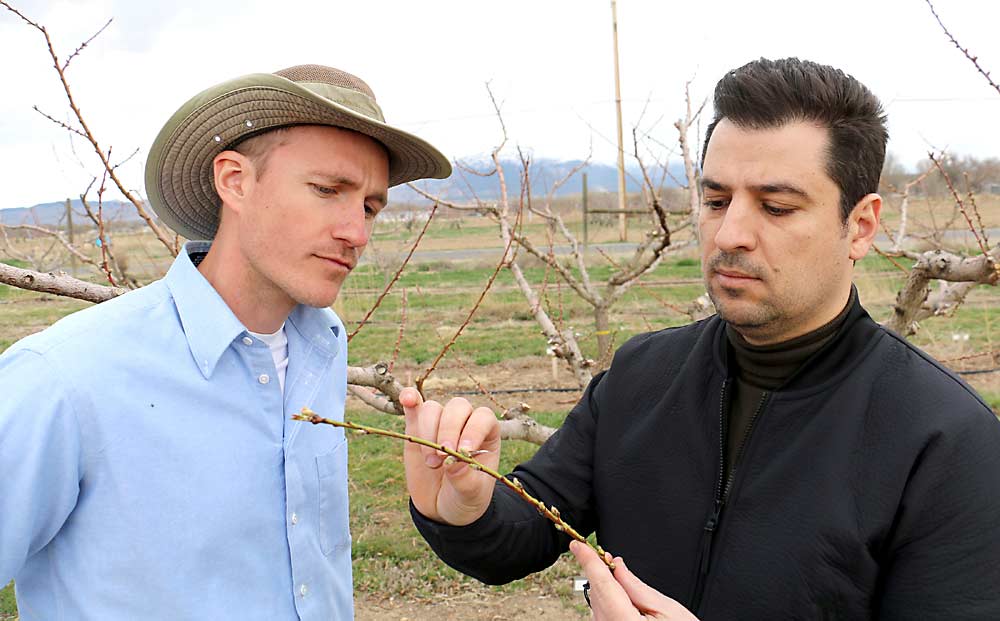
Late-winter and early-spring cold snaps can really do a number on peach buds, sometimes drastically reducing productivity and profitability. A new study suggests that a method called differential thermal analysis (DTA) may be a valuable tool for accurately pinpointing when a bud will break winter dormancy and begin growing and developing, and for identifying the temperatures that are lethal to buds.
That kind of information not only allows growers to make more informed management decisions in their orchards, it helps researchers to develop models to predict the cold-hardiness of cultivars and rootstocks, and to evaluate different horticultural practices to improve yield, according to study leader Ioannis Minas, assistant professor of pomology at Colorado State University.
Old vs. new methods
The standard method for evaluating cold damage is oxidative browning, a technique that involves collecting buds or shoots after the cold event, holding them at 70 degrees Fahrenheit for 24 hours, and then using a razor blade to slice into each individual bud to check whether it is green (alive) or brown (dead), Minas said.
“This technique can be performed on any phenological stage, which is its big advantage,” he said. “However, it is labor-intensive and not friendly for large data-handling, so it doesn’t fit really for developing prediction models.”
DTA is a much better option, Minas said.
Basically, the buds are collected, placed in a system chamber that includes a programmable freezer, and automatically monitored to determine the exact temperature at which the bud tissue freezes. The chamber in Minas’ lab can handle 300 to 360 buds per run, so it yields a wealth of data far more quickly than does oxidative browning.
DTA also delineates lethal from nonlethal freezing — when water freezes inside individual plant cells, buds die; when water freezes only outside the cells, they survive. All of this data is then available for analysis.
Using this technique, Minas and his research group gathered bud-laden shoots from Cresthaven, Red Haven and Sierra Rich during dormancy in the 2016–17 and 2017–18 seasons, and also from Suncrest during dormancy in the 2017–18 season. They then exposed the buds for two days to temperatures that were either cold (14 degrees) or warm (50 degrees) and calculated from the measurements to determine at which point each variety experienced 10 percent, 50 percent or 90 percent bud loss.
DTA can accurately predict cold hardiness and damage (ice formation) in dormant peach floral buds in mid- and late winter, as well as early spring, he noted, but loses this capacity as bud development advances in spring. Importantly, DTA can identify the timing of dormancy transitions that lead to the loss of acclimation, growth and development in peach floral buds.
Cold cultivars
So far, the DTA work suggests that Cresthaven is the most cold-hardy and Sierra Rich is the least. The technique also showed that Suncrest had an immediate response to low and high temperatures, acclimating very quickly after a cold event and quickly responding to warm weather.
Minas’ group has also been using DTA over the past three years to evaluate Red Haven on several rootstocks, including Atlas, Krymsk 1, Guardian, Krymsk 86, Lovell and Bright’s Hybrid 5. The data showed Guardian and Krymsk 86 were the most cold-hardy; and Atlas and Krymsk 1 were the least.
In addition, Guardian and Lovell consistently acclimated earlier in the fall and lost that acclimation earlier in the spring, while fall acclimation occurred later with Krymsk 86, Atlas and Bright’s Hybrid 5, and loss of acclimation in spring was “interestingly late” only in Krymsk 86, he said.
Minas is now expanding to study more than a dozen other peach cultivars and taking measurements from buds collected in additional locations in the state. This and previous data are all made available to growers through his group’s website (minas.agsci.colostate.edu/tree-fruit-information/cold-hardiness) and via weekly email updates.
Prediction models
With the data from DTA, he said, “we hope to develop some prediction models in the near future and provide a tool for comparative studies on cultural management practices, rootstocks and cultivars.” He is also working closely with other researchers, including several at Michigan State University who are beginning their own DTA studies on peaches.
MSU just received a DTA chamber to begin taking peach measurements, according to Bill Shane, MSU senior extension tree fruit specialist.
“We’re going to use it to look at peach rootstock effects and varietal differences in cold tolerance, and the effects of growth regulator treatments, fertilizer treatments and other treatments that might affect that,” Shane said.
He and other MSU researchers have been using the oxidative-browning method and cutting peach buds by hand, so they are looking forward to gathering more data more quickly with the DTA equipment.
Shane believes the equipment will be a boon to his peach breeding program, because he will be able to artificially drop temperatures in the chamber to mimic a cold snap, even if the actual winter is mild.
“One of the things I’m working toward in the breeding program is to have cold-hardy varieties, and with the equipment, I won’t have to wait for a test winter to be able to compare varieties,” he said.
Overall, Minas is encouraged about the project. “This DTA work is going to be really beautiful for stone fruit,” he said.
Minas’ DTA research is funded by Colorado Agricultural Station, Western Colorado Horticultural Society and CropWoRX. MSU’s DTA peach work and equipment are funded by the Michigan Tree Fruit Commission and Michigan Department of Agriculture’s Specialty Block Grant Program. •
—by Leslie Mertz






Leave A Comment